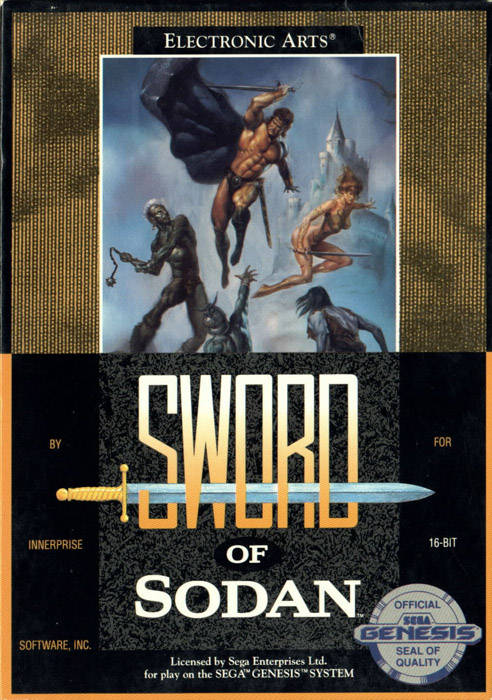
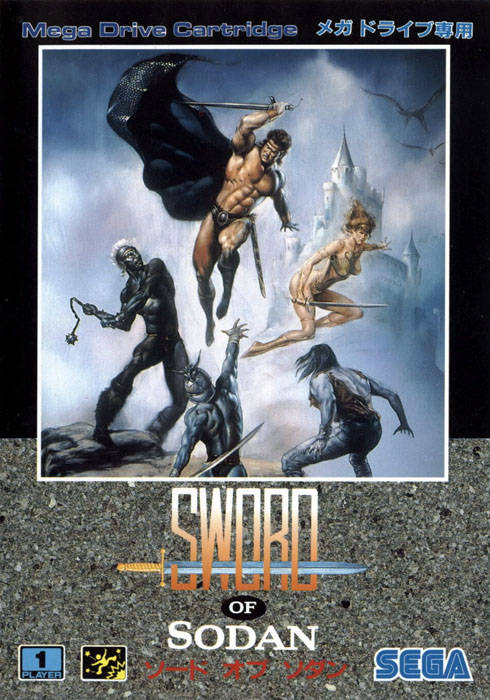
PLAYERS: 1
PUBLISHER: Electronic Arts (US/EU), Sega (JP)
DEVELOPER: Discovery Software International (port by Innerprise Software Inc.)
GENRE: Beat-em-up
RELEASE DATE: 1990 – (US), 01/1991 – (EU), 10/11/91 – (JP)
Sword of Sodan is another early Electronic Arts joint for the Genesis, which is a veiled way of saying it’s another crumbum computer port that doesn’t belong on Sega’s 16-bit console.
Unlike Zany Golf‘s awkward minigolf or Budokan‘s clunky martial arts, Sword of Sodan‘s foundation hails from a popular console genre: the beat-em-up. You control one of two rugged warriors (male or female) and take to the high streets of “Fantasy Town” (actual town name unknown) for some old fashioned slicing and slaying.
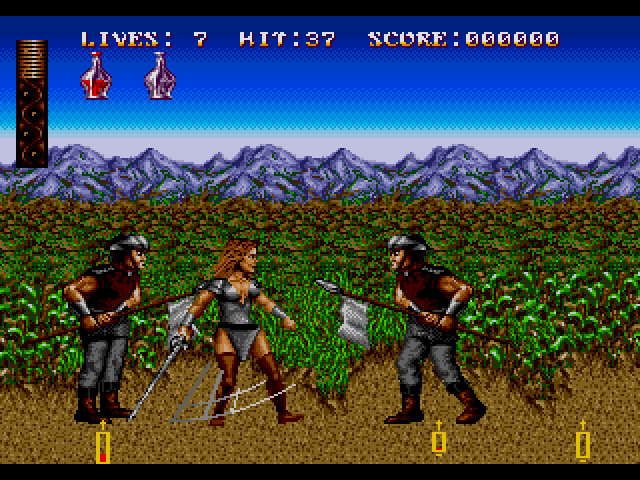
Early on, however, you’ll notice that Sword of Sodan doesn’t take its cues from console beat-em-ups like Double Dragon. Poetry greets you at the beginning of every stage, along with an incredibly well-rendered (and creepy) image of two hands holding a piece of a map. All character sprites are enormous. Various potions dropped by the enemy become integral to your progress. Finally, you can’t just hack-and-slash with your sword and hope you won’t get hit. Even with the large sprites, well-placed attacks are the only way you’ll make it through Sodan’s seven stages.
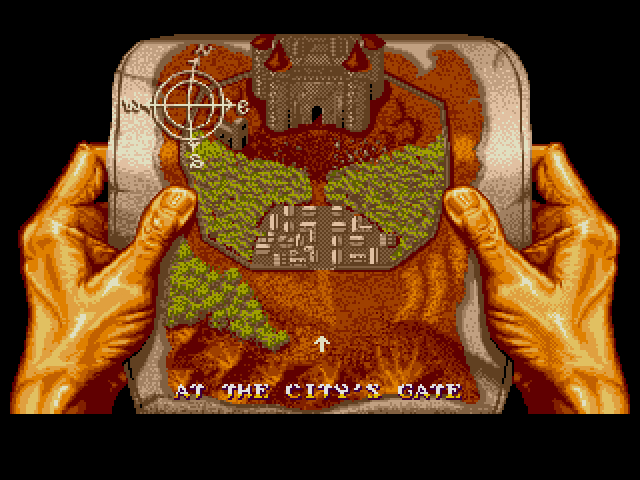
Sodan‘s combat is terrible and fascinating all at once. Enemies come at you from both sides, and at first, they seem stupid enough to stand near you and absorb your attacks. But as you move further into Fantasy Town, you’ll notice that your attacks have to be positioned just so in order to hit. Pressing ‘C’ combined with either ‘Up’, ‘Right,’ and ‘Down’ will shift the direction of your attack from the head to the gut to the shin, respectively. Some enemies won’t even absorb blows unless you hit them at a certain angle (and despite your weapon clearly making contact with them on screen). Some enemies seemingly won’t take hits at all, thanks to the game’s poor hit detection. Do what you can to move forward or just turn the game off.
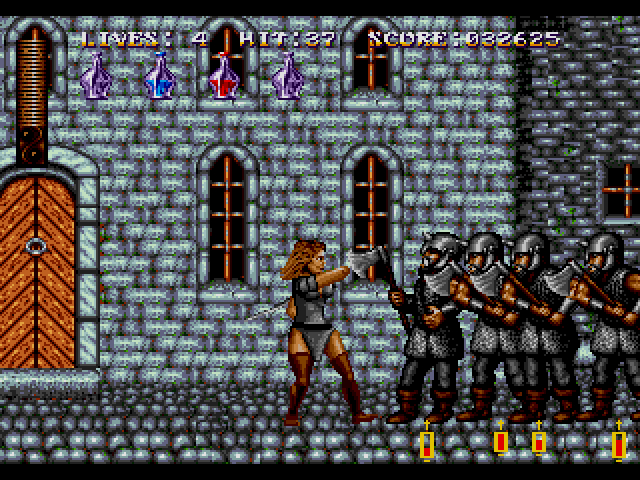
Sodan‘s combat is redeemed somewhat by its potion system. There are four different types – red, orange, blue, and transparent – all of which can be combined with each other to produce varying effects. Red increases your attack, orange defeats the closest enemy, and blue heals a portion of your life. The transparent potion does nothing unless you mix and match it with other color potions or save up four of them to skip a level. You can only have four potions in your inventory at any given time, so you’re encouraged to use them frequently. Be warned, though: some combinations will result in poisoning of your character.
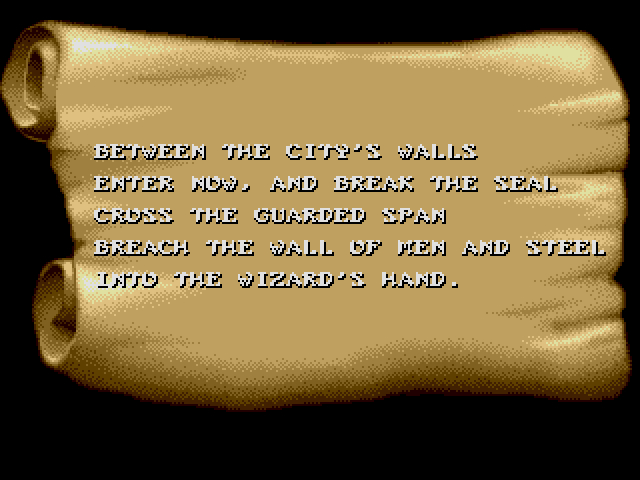
Potions will make all the difference, particularly in later levels. Your ability to cut down large imposing boss figures or not will often depend on if you have the right potions in your inventory. Unfortunately, the potions are randomly generated every time you turn on the game. This makes sense, but it can also hinder your ability to beat the game. Some playthroughs might give you all the right potions, while other playthroughs will screw you over.
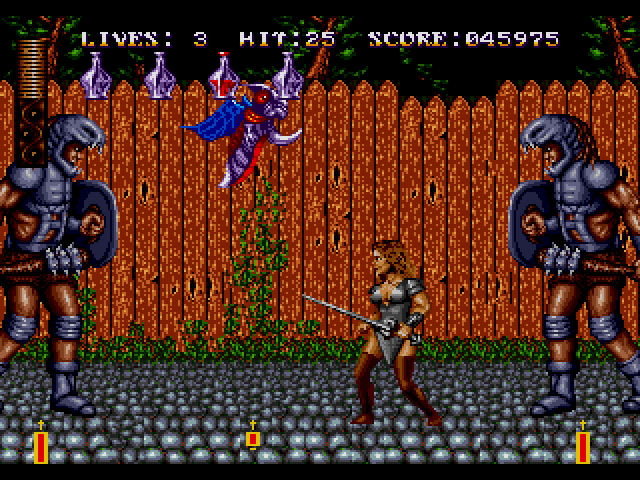
Not that you’ll necessarily want to play Sword of Sodan more than once. The potion system is a nice touch and fits well within the game’s stock fantasy landscapes, but outside of that, the game has zero depth. The increasingly ridiculous difficulty is there only to mask how short each of the game’s seven stages are. The slow, cumbersome combat – fitting, I suppose, for a PC beat-em-up circa 1988 – feels out of place with the Genesis’ modus operandi of intense, fast-paced action. Sheathe thy sword and tarry not in Sodan, lest thy disappointment overcome thy curiosity.
D+


7 replies on “Sword of Sodan (Genesis, 1990)”
What odd graphics! With sprites that big, you’d think action would need to be fast, frenetic, and tightly controlled. Sodan seems like the opposite.
If I could type out the “You lose!” sound from The Price Is Right, I’d do it here.
I remember seeing this game in a magazine before I got my Genesis. I was blown away by the graphics, and I couldn’t wait to try it. When I finally got a Genesis, it was one of the first games I rented. Man, what a huge disappointment!
Don’t tell me you’ve haven’t posted a review since May because you’ve been trying to get to later levels. (I might believe you.)
Rented this when it came out. Was horrible. That’s all I really can say about this game.
Haha, oh heavens, no. I did not linger long on Sword of Sodan.
This game is crap, I saw a few reviews on YT were they criticize this game for being too bad mostly because of the abysmal hitbox detection and other ridiculous stuff
This game is poor and no fun to play at all.
Whilst playing it I wondered if the developers themselves actually played it and what their honest reaction was to their own game because if I had made this I would have panicked like mad about the reaction it would get on release.
I don’t actually know anyone who likes this game it is just button mashing fodder that doesn’t even look good – one of the reasons I don’t like Rastan Saga 2 is partly because it looks like this game although admittedly Rastan controls a lot better.
This one is so joyless that it must surely be a contender for inclusion of a top ten worst games on the system list.
I’m surprised that games like Sword of Sodan and Slaughter Sport were allowed to be released for the Genesis. They’re unplayable.